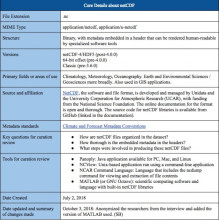susan borda
Posts by susan borda

In Web Archiving, do you get just the images or the entire site with most functionality intact?
This blog will cover the process of just getting the image files and related text in Part 1. Part 2 will cover the process of making the JavaScript-enabled site function when run locally, allowing the content to have more meaning by being displayed in context.
This blog will cover the process of just getting the image files and related text in Part 1. Part 2 will cover the process of making the JavaScript-enabled site function when run locally, allowing the content to have more meaning by being displayed in context.
•
In the Spring of 2021, a researcher I regularly work with informed me that he had included the citation to his dataset in the References section of the paper that he had just submitted to AGU JGR Planets, https://agupubs.onlinelibrary.wiley.com/doi/10.1029/2021JE006875. I thought it was an excellent opportunity to follow one of our datasets through the process from a mention in the References section all the way through to the DataCite Data Metrics badge, https://support.datacite.org/docs/displaying-usage-and-citations-in-your-repository, in the Deep Blue Data repository indicating this dataset has been cited.
•
In early 2021, I was trying to verify whether the DataCite Data Metrics badge, https://support.datacite.org/docs/displaying-usage-and-citations-in-your-repository a tool for displaying usage and citation information, was working or not. However, I had no easy way of knowing whether any of our researchers had actually cited any of the data sets we host in Deep Blue Data in their published articles, let alone whether other researchers had. So, I decided to begin the process of adding citations to our datasets via the DataCite API, based on information we have in our “Citations to related material” field. I was using the instructions on https://support.datacite.org/docs/contributing-data-citations#.
The following is my process and the results of that process.
The following is my process and the results of that process.

In the UMich Research Data Services (RDS) group, we see and work with all sorts of data. One particularly thorny variety is netCDF. In Deep Blue Data, we have been getting regular deposits of data in this format, and we didn't know much about it. We had many questions how do we open it, what's its structure, how do researchers create these files and why can the size vary so widely from 100s of MBs to 100s of GBs or even TBs? Jake Carlson, Director of RDS, and I hashed out the idea of creating "profiles" for file formats as quick reference resources for RDS as well as others in the data curation field to help us do our jobs more easily and consistently. So, we thought we'd pilot this idea by creating a “Data Curation Format Profile” (DCFP) for netCDF data files since it seemed like an interesting file format and we were likely to get more of them in the future.